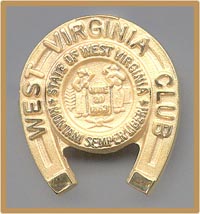

 |
West Virginia |
In 1716, Alexander Spotswood, lieutenant governor of Virginia, led an expedition across the Blue Ridge Mountains into the Shenandoah Valley in an effort to promote settlement of western Virginia. Upon returning across the mountains, Spotswood presented a golden horseshoe to each member of the party.
The Golden Horseshoe program began in 1929 when noted historian Phil Conley proposed the creation of West Virginia Clubs, designed to promote appreciation of the Mountain State. State school superintendent William C. Cook believed that students "should learn more about the State, since they are our future citizens and should be fully prepared for citizenship. They should have a knowledge of the past and present status of the State in order to estimate its future possibilities." Two years later, the first Golden Horseshoe test was given, and resulted in the awarding of pins to 87 students from 46 counties. These scholars were dubbed Knights and Ladies of the Golden Horseshoe. This marked the beginning of the Golden Horseshoe program, the longest running of its kind in the United States.
The information in the database was extracted from Golden Horseshoe programs, 1931-2007. A few additional names were found in the state superintendent's reports. Programs for the years 1943 to 1946 were not located. These names were provided by the State Department of Education. No program could be found for 1941, but African-American winners for this year were listed in the Report of the State Superintendent of Free Schools. Because the information was taken directly from the programs, there may be errors in spelling. If you are unsuccessful in locating a name, you may wish to search by county or year.
Corrections may be sent to Mary Johnson.
Try our West Virginia History Quick Quizzes and answer our Daily Trivia question.
Note: For information on replacing a lost Golden Horseshoe pin, go to the Department of Education Lost Pin Web page.
Honorary Golden Horseshoe Recipients
West Virginia Archives and History